
Structural basis of antiphage defence by an ATPase-associated reverse transcriptase
@jerrintgeorge.bsky.social
@jerrintgeorge.bsky.social
Postdoc at Wiedenheft Lab 🥼 | Former HFSP postdoctoral fellow at Sternberg Lab| 🧬 CRISPR-Cas enthusiast | Interested in mobile genetic elements https://scholar.google.com/citations?user=sJ8ogyEAAAAJ&hl=en&oi=ao

Structural basis of antiphage defence by an ATPase-associated reverse transcriptase
@jerrintgeorge.bsky.social
I am happy to share our work on the mechanism of prokaryotic immunity by a reverse transcriptase associated with an SMC-family ATPase, now published in @natcomms.nature.com
🔗 nature.com/articles/s4146…
(🧵 on the bioRxiv version ⬇️)

Ever wondered why some bacteria have multiple CRISPR-Cas systems? Our new study led by Leah Smith shows how type I CRISPR systems can promote the acquisition and retention of new spacers into a co-occuring type III system. www.sciencedirect.com/science/arti...
18.08.2025 15:06 — 👍 62 🔁 25 💬 5 📌 0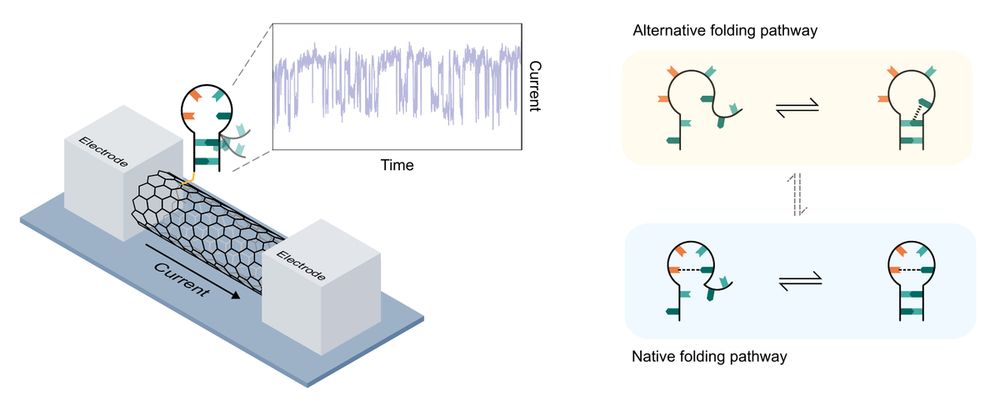
New from our lab in @narjournal.bsky.social:
We dissect the folding dynamics of a fundamental element of RNA secondary structure—a stem-loop—at single-molecule and microsecond resolution.
doi.org/10.1093/nar/... 1/5
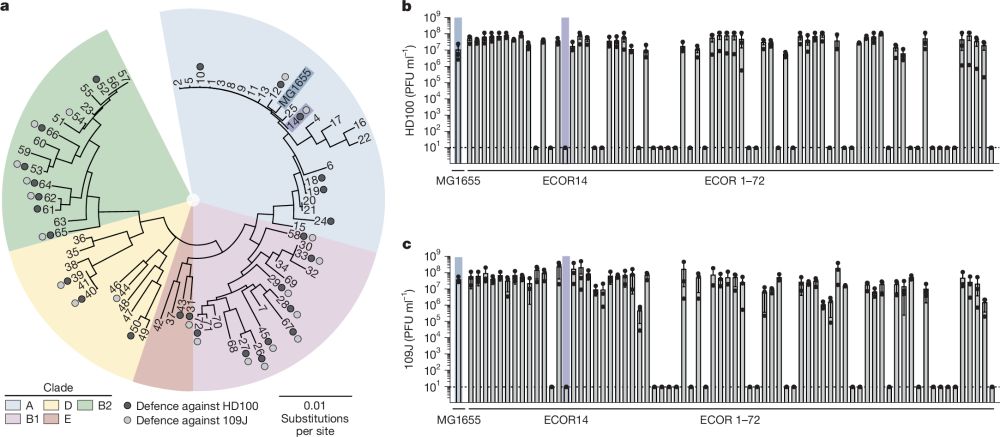
Words cannot describe how excited I am to share the findings from the second half of my postdoc in @aaronwhiteley.bsky.social's lab where we discover that bacteria use functional amyloids to defend themselves from predatory bacteria. rdcu.be/euu5Y. See thread for details on this epic adventure 1/.
02.07.2025 20:10 — 👍 164 🔁 52 💬 6 📌 4
We wrote a review on Transposable Elements (TEs) and almost all aspects of TE silencing and their roles in biological processes & disease.
www.nature.com/articles/s41...
New Preprint!! Alejandro González-Delgado accomplished a major feat on this one: ported retron recombineering, which we love so much in E. coli, into 14 new bacterial species via a massive collaborative effort involving 9 labs!
www.biorxiv.org/content/10.1...
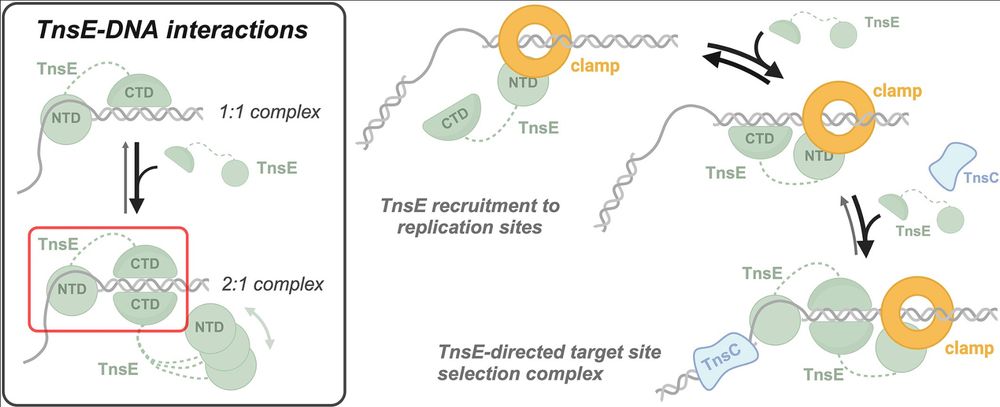
Exciting work from the Guarné lab indicating how the elusive TnsE pathway of prototypic Tn7 recognizes DNA replication features using an asymmetric dimer to integrate multiple signals at DNA replication forks linking target recognition to transposase recruitment doi.org/10.1093/nar/...
15.06.2025 11:43 — 👍 12 🔁 5 💬 0 📌 1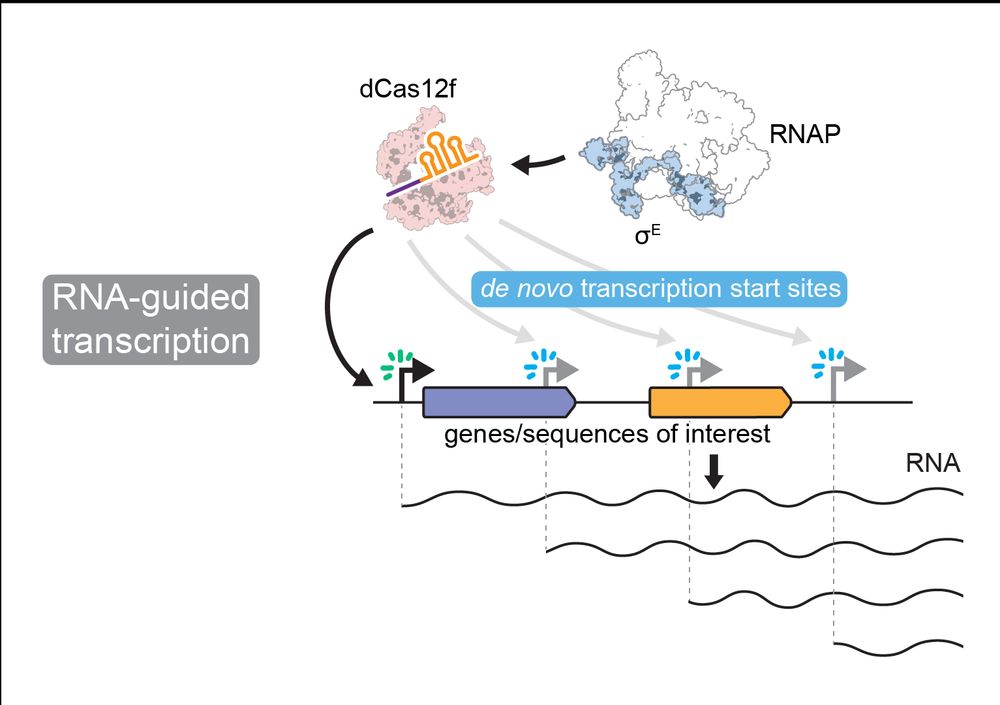
1/10 New pre-print(s) from the Sternberg Lab in collaboration with Leifu Chang's Lab! We uncover the unprecedented molecular mechanism of CRISPR-Cas12f-like proteins, which drive RNA-guided transcription independently of canonical promoter motifs.
Full story here:
www.biorxiv.org/content/10.1...
We're thrilled to share the published version of our DRT9 story, online today @nature.com! Congratulations to all authors!
www.nature.com/articles/s41...
@science.org 🧫🧬❄️🔬 Molecular basis of influenza ribonucleoprotein complex assembly and processive RNA synthesis | Science www.science.org/doi/10.1126/...
@yiweichang.bsky.social www.yiweichanglab.org @jiwasa.bsky.social #virology #Influenza #Cryo-EM #StructuralBiology #RNA #polymerase
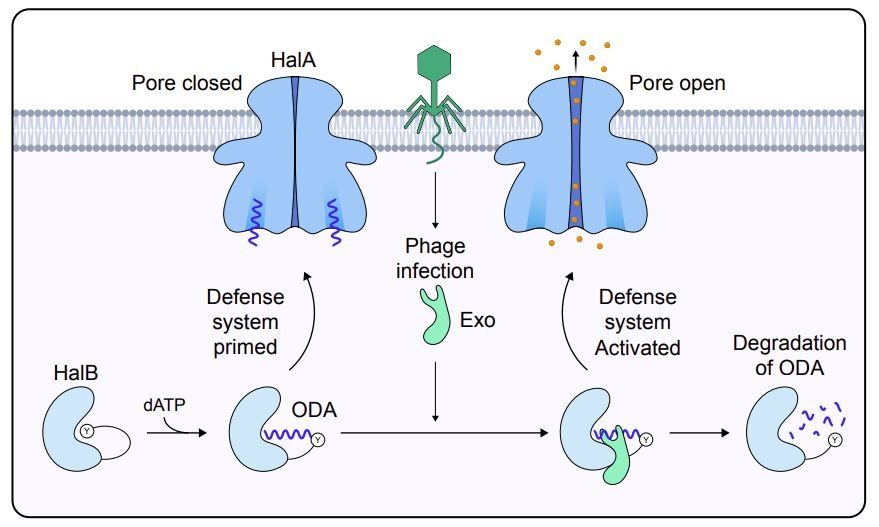
A beautiful discovery by Joel Tan and Philip Kranzusch, out today in Nature:
A DNA-gated molecular guard controls bacterial Hailong anti-phage defence
Congrats Joel and Philip! Was a pleasure to contribute to this discovery together with Sarah Melamed
www.nature.com/articles/s41...
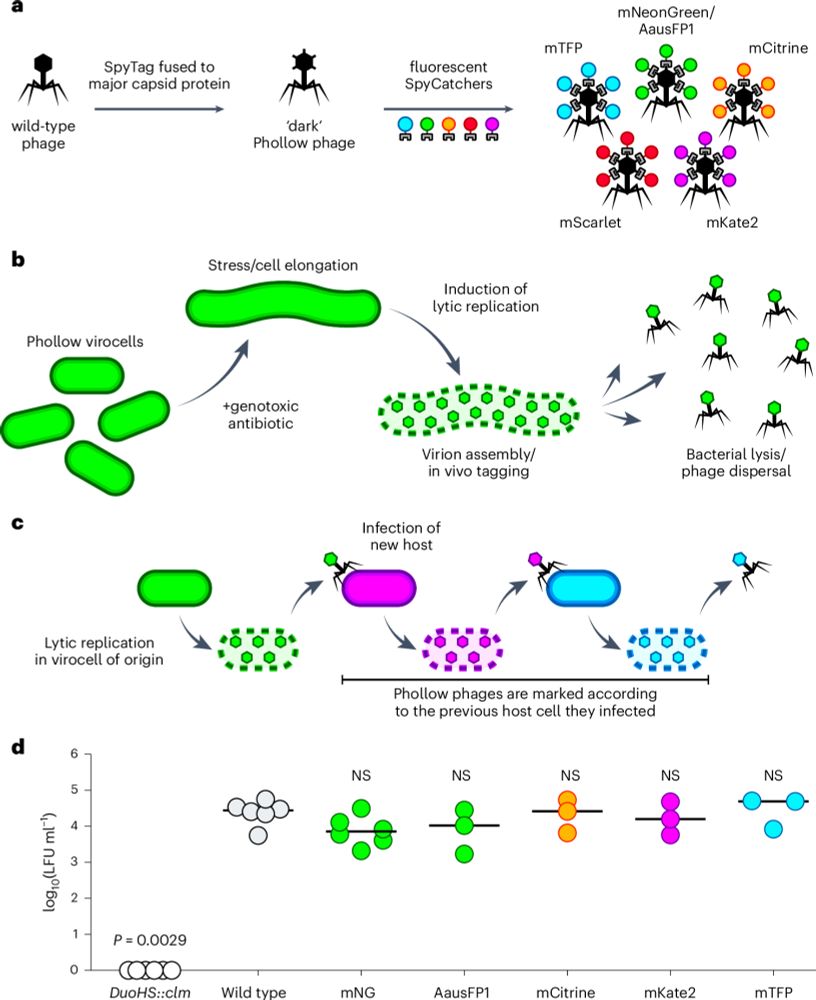
I am thrilled to share the first manuscript from the Wiles lab! We present "Phollow", an in vivo phage-tagging approach that enables direct observation of phage outbreaks with single-virion resolution by live imaging. Here some highlights 👇 www.nature.com/articles/s41...
18.04.2025 18:38 — 👍 106 🔁 39 💬 5 📌 4Check out our new story led by @aesully98.bsky.social describing how bacteria turn immune evasion against phage! In collaboration with @benmorehouse.bsky.social lab, we discover that bacteria guard their nucleotide second messenger pool using a nucleotidyltransferase related to Cas10/CRISPR enzymes
08.04.2025 02:52 — 👍 28 🔁 11 💬 1 📌 0Interested in phage defenses that natively block lytic phage used in therapies?
Or do you want to figure out if a phage has a modified genome?
Meet the END-nucleases, an enzyme family that can broadly restrict phages with many diverse modifications. From talented post-doc Wearn-Xin Yee!

Huge thanks to the Wiedenheft Lab—especially Senuri, Murat, Quynh, Royce, Adelaide, Hannah, Adelaide, Ava and our newest faculty Steve—this work wouldn’t have been possible without your support, insight, and suggestions! 🙏
27.03.2025 13:58 — 👍 0 🔁 0 💬 0 📌 0I'm incredibly grateful to Blake Wiedenheft for being an amazing mentor throughout my time in his lab.
27.03.2025 13:58 — 👍 0 🔁 0 💬 1 📌 0Huge thanks to my co-first author and colleague Nate Burman, who helped me learn cryo-EM. Here’s a fantastic movie he made that captures the key mechanistic steps of this unusual immune system in action!👇
27.03.2025 13:58 — 👍 0 🔁 0 💬 1 📌 0
Altogether, our findings reveal how an RT-ATPase immune system assembles a viral surveillance complex using a cDNA ‘harpoon’. Phage flap nucleases trigger its activation, leading to tRNA depletion and translation arrest—while phages fight back by encoding their own tRNAs.
27.03.2025 13:58 — 👍 1 🔁 0 💬 1 📌 0
Interestingly phages evade this ATPase-associated RT immune system by encoding their own tRNA-Ser genes! Comparison between phage encoded tRNA-Ser and E.coli tRNA-Ser revealed major differences clustered in the D-loop, which is key for recognition by aminoacyl tRNA synthetase.
27.03.2025 13:58 — 👍 0 🔁 0 💬 1 📌 0
Upon co-expressing the retron with phage flap nuclease, we observed nucleoid compaction in E. coli—a hallmark of translation arrest—driven by HNH-mediated depletion of tRNA-Ser. Recently Azam et al. (Nov 24) showed that expression of ATPase+HNH from Eco7 retron depletes tRNA-Tyr.
27.03.2025 13:58 — 👍 0 🔁 0 💬 1 📌 0
We then asked: what triggers this system? By sequencing phages that survive retron defense and expressing candidate genes, we found that phage-encoded flap nucleases (yes! the ones that remove Okazaki fragments) are baited to cleave the cDNA scaffold, activating the complex.
27.03.2025 13:58 — 👍 0 🔁 0 💬 1 📌 0
We find that HNH is recruited asymmetrically, either in an up or down orientation relative to the RT, and is anchored by a specialized C-terminal claw formed by the ATPase homodimer. Mutations at the ATPase–HNH interface or in claw-stabilizing residues abolished defense.
27.03.2025 13:58 — 👍 0 🔁 0 💬 1 📌 0
The long coiled-coil domains of SMC-family ATPases—which typically wrap DNA in repair complexes like Rad50—facilitate interdimer contacts in the retron complex, forming 'bear hug' and 'dorsal fin'-like structures that flank either end of the cDNA scaffold.
27.03.2025 13:58 — 👍 0 🔁 0 💬 1 📌 0
Using cryo-EM, we determined that this immune system forms a 364 kDa phage surveillance complex where the extrachromosomal cDNA—made by the RT using the ncRNA—acts as a molecular scaffold to recruit two ATPase homodimers and the nuclease.
27.03.2025 13:58 — 👍 0 🔁 0 💬 1 📌 0
Prokaryotic RTs have recently been shown to be key players in antiviral defense. Our story began with a simple question—how does a molecularly odd association of an RT, SMC-ATPase, structured ncRNA, and HNH nuclease (also called retron I-A) orchestrate phage defense?
27.03.2025 13:58 — 👍 1 🔁 0 💬 1 📌 0
I am super excited to share our work uncovering the structure and mechanism of an ATPase-associated reverse transcriptase (RT) involved in prokaryotic antiviral defense, now available as a preprint on bioRxiv!🧬🦠🔬
www.biorxiv.org/content/10.1...
🧵👇
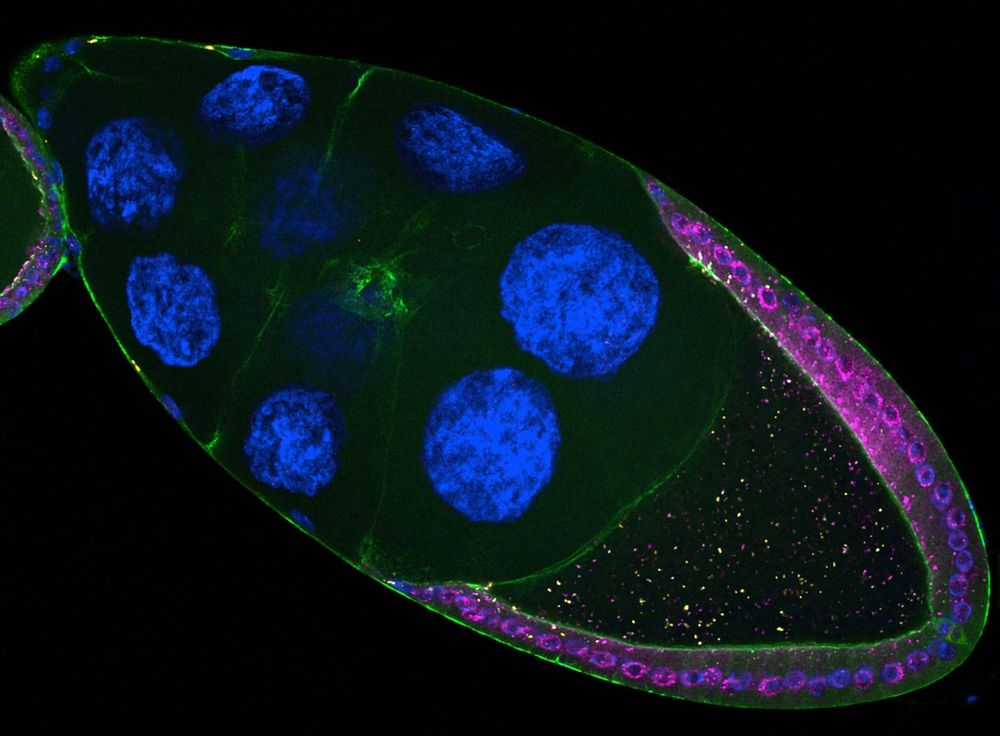
Drosophila follicle showing retrotransposons (pink & yellow) expressed in somatic cells infecting the oocyte
1/ Transposable elements are often called "jumping genes" because they mobilize within genomes. 🧬
But did you know they can also jump 𝘣𝘦𝘵𝘸𝘦𝘦𝘯 cells? 🤯
Our new study reveals how retrotransposons invade the germline directly from somatic cells.
www.biorxiv.org/content/10.1...
A short thread 🧵👇